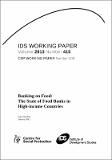Banking on Food: The State of Food Banks in High-income Countries
Abstract
Food banks provide food to charities and other grassroots organisations for supporting vulnerable populations. As such, they tend to complement more institutionalised, state-provided safety net programmes. This paper is a first attempt to estimate the total number of people supported by food banks in high-income countries (HICs). The analysis shows that nearly 60 million people turn annually to food banks in 'rich' nations – that is, a level similar to the entire population of France or Italy and representing about 7.2 per cent of the HIC population. Such level could be considered a conservative estimate. This scenario suggests a number of implications for social protection policy, as well as opening new frontiers for food assistance practice, partnerships and applied research.
The paper concludes that (i) the need for food banks will likely stay high or even increase further in the coming future; (ii) food bank models, activities and operations require further review, appraisal and documentation; (iii) debates should not confuse responses to and causes of poverty, food insecurity and socio-economic marginalisation; and (iv) the nature, context and objectives of food assistance in advanced economies are different from those in developing countries, although scope for galvanising cooperation exists.
Citation
Gentilini, U. (2013) 'Banking on Food: The State of Food Banks in High-income Countries', IDS Working Paper 415, Brighton: IDSIs part of series
IDS Working Paper;415More details
http://www.ids.ac.uk/publication/banking-on-food-the-state-of-food-banks-in-high-income-countriesRights holder
Institute of Development StudiesCollections
- IDS Research [1671]

